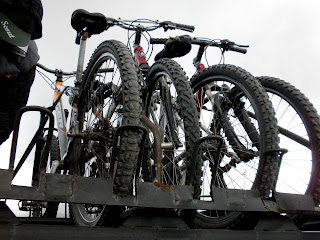Debra, Mel and I climbed a small section of Cotopaxi today and it was stupendous. I have been admiring Cotopaxi from afar since we arrived. It is a beautiful mountain, shaped as a cone, with glaciers reaching halfway down from the summit. Still an active volcano, it erupts approximately once every hundred years, and is due for another eruption, since it last erupted 114 years ago. It is a popular peak to climb, being that it is not a technical climb at almost 600o metres.
 Hiking up Lava Flows
Hiking up Lava Flows Refugio Floats out of the Mist
Refugio Floats out of the Mist Cotopaxi Glacier Above Us
Cotopaxi Glacier Above Us Closer to Glacier
Closer to Glacier Touching the Glacier
Touching the GlacierWe climbed another 200 metres to reach the glacier, which is melting 7 to 8 metres a year. The refugio uses glacier water, and pipes go from the glacier to the refugio. We ran into two seismographs, which are placed to measure the activity of the volcano, and which hopefully are actually working and ready to predict the next eruption. The glacier was huge and it was very humbling when I stood next to it. Somehow this second part of our hike was much easier and we appeared to be energized by the view of the glaciers.
Luis, our guide, prepared us chicken soup, guacamole and chips, and tuna salad, which we gobbled up. I took Ibuprofen in anticipation of altitude sickness, but I never did feel unwell. Descending the mountain was easier, although the terrain was sandy and slippery. The mountain was drenched in fog and the mist was so thick drops of water kept us wet all the way up and most of the way down. Visibility was limited during our ascent and descent, but for a few minutes on our way down the sun shone through and the summit was visible. It was important to look back and pay attention, or we would miss it.
We then mounted the bikes for a 14 kilometre downhill coast to 'Limpiapungo' lake nearby. Mel and our companion Winslow sent full speed downhill, while Debra and I took our time and stopped several times on our way down looking for birds, and admired the paramo vegetation and the mountain when it peaked out for a minute, and Ruminahui (volcano) ahead of us past the lake. We encountered wild horses and cows; they all ran away in fear when they saw us. It was an exhilarating ride, especially during the few seconds when we looked back and saw Cotopaxi peaking through the clouds.
We met Luis and the jeep just as the rain began in earnest. The sky was grey and ominous and threatening, so it was the right time to leave the mountain. We drove through fields of pine trees and eucalyptus, which are not native to the area. It is disconcerting that in a national park, farmers plant trees for profit. The original flora is grass paramo and cushion paramo, which we saw higher up, as well as lichens and bushes low to the ground, sometimes with bright blue or red or yellow. It was the end of the day and Cotopaxi was invisible again behind grey clouds.
Getting Bikes on Jeep Just in Time to Escape the Rain
Did we really climb to 5000 metres in the mist, or did we dream it? We stopped at a converted hacienda/hosteria near Machachi for tea and chocolate cake, and drove back to Quito in an altered state.
There was little time to rest once home. Maya had had a super exciting day too. When we were waiting for our ride to Cotopaxi, I had read the local newspaper and was stunned to see a photo of Maya in the Culture section of 'El Comericio' along with an article about her concert at the Casa de la Musica tonight. She had been invited to play at a master class for the conductor from Julliard in the afternoon, and was concertmaster for her orchestra. Debra and I changed quickly to join Eric at the concert hall, where we enjoyed the March from Carmen and from Aida and watched Maya shaking the conductor's hand several times throughout the performance.
 Looking Down From the Refugio
Looking Down From the Refugio



 Wild Horses in the Park
Wild Horses in the Park Flowers Used by Locals for Altitude Sickness
Flowers Used by Locals for Altitude Sickness
 Birdwatching
Birdwatching Ruminahui in the Distance
Ruminahui in the Distance
 Biking to Limpiapungo Laguna
Biking to Limpiapungo Laguna
 Lovely Paramo Flowers
Lovely Paramo Flowers
No comments:
Post a Comment